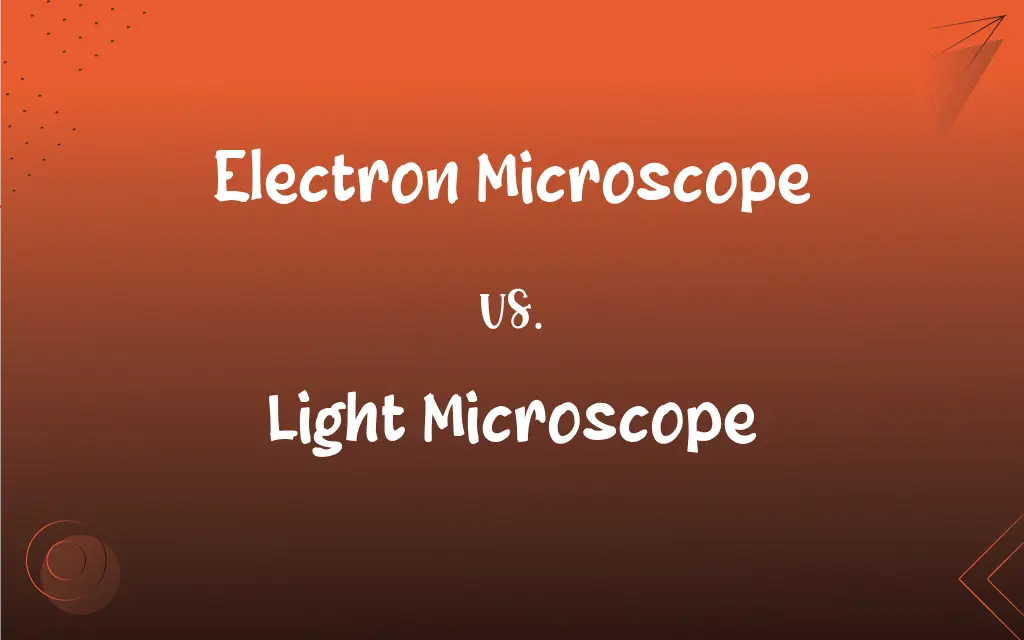Electron Microscope vs. Light Microscope: What's the Difference?
Edited by Aimie Carlson || By Harlon Moss || Updated on October 9, 2023
Electron microscope uses electron beams for magnification, achieving higher resolution. Light microscope uses visible light and glass lenses, limiting its magnification.

Key Differences
Electron microscopes have enabled scientists to peek into the ultra-microscopic world by utilizing electron beams. The electron microscope can reveal details up to 0.1 nm in size, thus showcasing the internal and external structure of objects not visible to the naked eye. Light microscopes, utilizing light waves, have limitations in revealing such tiny details due to the wavelength of visible light. In this context, light microscopes provide detailed visuals only up to around 200 nm.
The electron microscope is famous for its usage in fields requiring meticulous details like virology and materials science due to its immense magnification capabilities. On the other hand, light microscopes are prevalent in educational institutions and less research-intensive laboratories due to their ease of use and significantly lower costs.
The electron microscope, being more technologically advanced, requires a specialized environment to function optimally, including vibration-free platforms and sometimes even vacuum conditions. In stark contrast, the light microscope is much more tolerant of its surroundings and can be used in various environments without requiring specialized settings or strict conditions.
In terms of user-friendliness, electron microscopes typically involve a steeper learning curve and require users to have specific knowledge and training. In comparison, light microscopes tend to be user-friendly and are often introduced to students at early educational levels due to their simplicity and ease of operation.
An electron microscope is particularly useful when the study involves inanimate objects or dead biological specimens due to its beam's potential destructive nature. Alternatively, light microscopes are versatile in observing living organisms and are commonly utilized in biological and medical research for observing live cell cultures and tissue samples.
ADVERTISEMENT
Comparison Chart
Article Usage
An electron microscope is used for high-resolution imaging.
A light microscope is used in schools.
Pluralization
Electron microscopes require specialized training.
Light microscopes are widely accessible.
Associated Adjectives
High-resolution images are obtained using electron microscopes.
Basic biological studies utilize light microscopes.
Usage in Compound Nouns
Electron microscope technicians are specialists.
Light microscope slides are commonly used.
Prepositional Phrases
With an electron microscope, atoms can be seen.
Under a light microscope, cells are observed.
ADVERTISEMENT
Electron Microscope and Light Microscope Definitions
Electron Microscope
An electron microscope uses electron beams for magnifying specimens.
The virus was thoroughly examined under the electron microscope.
Light Microscope
Light microscopes are commonly used in educational settings.
Each lab station was equipped with a light microscope.
Electron Microscope
Electron microscopes are pivotal for observing ultra-fine structural details.
The electron microscope revealed the intricate pattern of the metal alloy.
Light Microscope
A light microscope uses visible light to magnify specimens.
The student observed the onion cells using a light microscope.
Electron Microscope
Electron microscopes can achieve much higher resolution compared to optical ones.
Detailed nanostructures were visible with the electron microscope.
Light Microscope
Light microscopes allow for the observation of living organisms.
Scientists watched the moving paramecium under a light microscope.
Electron Microscope
Electron microscopes require vacuum conditions for optimal functioning.
Researchers ensured vacuum conditions before using the electron microscope.
Light Microscope
Light microscopes are user-friendly and require minimal training.
She quickly learned how to use the light microscope in her biology class.
Electron Microscope
Electron microscopes can provide three-dimensional imaging of specimens.
The scientist generated a 3D model using the electron microscope.
Light Microscope
Light microscopes typically offer lower resolution than electron microscopes.
The light microscope couldn’t provide clarity on the viral structure.
FAQs
Why are electron microscopes not suitable for observing living organisms?
Electron microscopes often require vacuum conditions and use electron beams, which can be harmful to living cells.
How does a light microscope magnify objects?
Light microscopes use visible light and a series of lenses to magnify objects.
Why are electron microscopes not as common as light microscopes in educational institutions?
Electron microscopes are generally less common in educational settings due to their high cost, complexity, and stringent operating conditions.
Can the light microscope be used to visualize viruses?
Typically, light microscopes cannot visualize viruses clearly due to their limited resolution compared to the small size of viruses.
In what educational contexts are light microscopes typically utilized?
Light microscopes are widely used in biology classes in schools and universities to study cell structures and microorganisms.
Can light microscopes be used to view individual atoms?
No, light microscopes lack the resolution to view individual atoms due to the limitations imposed by the wavelength of light.
How does an electron microscope achieve higher resolution than a light microscope?
Electron microscopes use electron beams, which have much shorter wavelengths than visible light, enabling them to reveal finer details.
What is one major limitation of using an electron microscope for biological studies?
Electron microscopes can potentially damage biological samples due to the high-energy electron beam and typically cannot be used to view living organisms.
What is a critical application of electron microscopes in science?
Electron microscopes are crucial for exploring ultrastructural details in materials science and biological research, revealing details invisible to light microscopes.
Why are samples in electron microscopes often coated in gold?
Samples in electron microscopes are sometimes coated in gold to increase conductivity and provide a better image by minimizing charging under the electron beam.
What type of images do electron microscopes produce?
Electron microscopes can produce highly detailed, often black and white, 2D or 3D images at extremely high magnifications.
Is it possible to observe chemical reactions with an electron microscope?
Observing chemical reactions directly under electron microscopes can be challenging due to the vacuum conditions and potential sample alteration by the electron beam.
Is it possible to observe a live cell using an electron microscope?
Traditional electron microscopy methods are not suitable for observing live cells as the conditions (e.g., high vacuum, electron beam) can be harmful to them.
Can light microscopes magnify as much as electron microscopes?
No, light microscopes are limited by the wavelength of light and cannot achieve the high magnifications and resolutions of electron microscopes.
What is the key technology behind an electron microscope?
Electron microscopes use electron beams to illuminate and magnify specimens.
Are light microscopes suitable for professional research?
Yes, light microscopes are used in professional research, especially in biological studies involving live specimens and where high magnification is not crucial.
What is a common type of electron microscope used in research?
The Transmission Electron Microscope (TEM) is commonly used in research for obtaining highly detailed, ultra-high-resolution images of specimens.
How are colors observed in specimens under the light microscope?
Colors can be naturally observed or artificially introduced through staining to enhance contrast and details when using a light microscope.
What is a practical application of light microscopes in medical laboratories?
Light microscopes are commonly utilized in medical labs to observe blood samples, identify pathogens, and assist in diagnosing diseases.
What is the working principle behind a light microscope?
Light microscopes operate by passing visible light through a specimen and then through glass lenses, which magnify the image.
About Author
Written by
Harlon MossHarlon is a seasoned quality moderator and accomplished content writer for Difference Wiki. An alumnus of the prestigious University of California, he earned his degree in Computer Science. Leveraging his academic background, Harlon brings a meticulous and informed perspective to his work, ensuring content accuracy and excellence.
Edited by
Aimie CarlsonAimie Carlson, holding a master's degree in English literature, is a fervent English language enthusiast. She lends her writing talents to Difference Wiki, a prominent website that specializes in comparisons, offering readers insightful analyses that both captivate and inform.































































